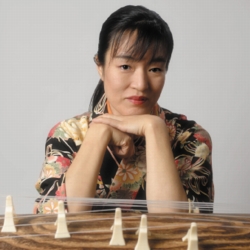Mitsuki Dazai

photo: © chris leck
Mitsuki is a graduate of Japan's renowned Kunitachi College of Music in Tokyo where she majored in vocal performance in the Western Classical tradition. During the course of her studies, she felt drawn to the non-western traditions of Eastern Europe, the Middle East and Asia. Interest in these areas eventually led Mitsuki on a circuitous route to a discovery of traditional Japanese music and the koto. She studied traditional koto music at the Ikuta School. Inspired by the cultural veneration for this instrument, she next pursued advanced studies in contemporary koto music at Sawai Sokyokuin, with instruction by modern koto Master Tadao Sawai and world-renowned Kazue Sawai.
Mitsuki is currently active as a solo and ensemble concert artist and collaborates with various artists. Her musical background is both diverse and extensive as a performer and innovator, arranging and composing koto music in different styles. Not limiting herself to music traditionally associated with the koto, her performances often incorporate western, pop and improvisational elements and arrangements, challenging the many voices of the koto and allowing her to relate the kotoutf's appeal to a variety of audiences.
About the Composers
Born in Paris of Czech parents in 1939, Tomas Svoboda composed his first opus at age 9 and was admitted to the Prague Conservatory 5 years later as its youngest student. After graduating from the Conservatory, numerous performances and radio broadcasts of his music brought national recognition to Svoboda, clearly establishing him as Czechoslovakia's most important young composer. In 1964 the Svoboda family settled in the United States, where Svoboda enrolled at the University of Southern California in 1966, graduating 2 years later with honors. Of his symphonic pieces, 430 have been performed by major orchestras such as the Boston, Philadelphia, Cleveland, San Francisco, Monte-Carlo, Prague and Nagoya Philharmonic orchestras. All in all, over 1200 performances of his music have been counted.
Yatsuhashi Kengyo (1614-1685)
Yatsuhashi Kengyo, a blind koto player, is well known as the inventor of Hira-joshi (basic scale of traditional koto music). The honorific title Kengyo was awarded during the Edo period as a sign that the person is a member of the highest class in the society of the blind. He was recognized as one of the Kengyo because of his rare talent with the koto and became known as a "Father of the koto". For over 300 years his compositions have continually been loved and enjoyed.
Tadao Sawai (1937-1997)
Sawai began studying koto at the age of 10. At the age of 11 he performed on the NHK (Japan Broadcasting Corporation) radio for the first time, and in 1959 he was awarded the NHK "Hope of the Year" award for promising new artists. After graduating from Tokyo National University of Fine Arts and Music in l960 he embarked on a tour of recitals through which he hoped to create renewed interest in the koto. His aim was to develop both the technical and artistic range of the instrument. Sawai is known for his dynamic playing style, willingness to experiment and improvise and for his talent in challenging the limits of modern koto playing.
Michio Miyagi (1894-1956)
Miyagi lost his sight when he was 8 years old and dedicated the rest of his life to the koto.
In 1907 he moved with his family to Incheon, South Korea, continuously playing the instrument
until reaching the rank of a Kengyo. Miyagi moved to Tokyo in 1917 and began giving recitals
of his own compositions. He was recognized as an authority in the new Japanese music, achieving
recognition in the early Showa period. Inspired by his introduction to western music, Miyagi felt
the need to invent a new variation of the koto called jushichigen. This 17-string bass koto allowed
him a more dynamic expression of his musical passion. Miyagi also became known for the lovely
pieces he created especially for children.
Hikaru Sawai (1964- )
Hikaru Sawai began his musical studies at the Toho Academy of Fine Arts for Children. Although
trained in classical koto by his father, the renowned Tadao Sawai, and later having studied the
shakuhachi with the distinguished artist, Katsuya Yokoyama, Sawai took a turn away from tradition
and formed a rock band. With Sawai composing and playing guitar, the group gained a strong following.
Beginning in 1986 the young performer was gradually drawn back into the world of koto through
appearances in his father's "All Japan" concert series, but finally ended up having his own concert
tours around the world. His progressive compositions appeal to the younger generation.





